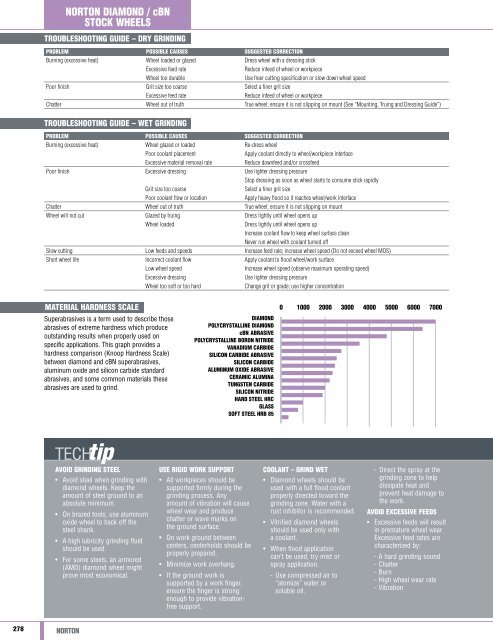Create successful ePaper yourself
Turn your PDF publications into a flip-book with our unique Google optimized e-Paper software.
<strong>Norton</strong> Diamond / cBN<br />
Stock Wheels<br />
Troubleshooting Guide – Dry Grinding<br />
Problem Possible Causes Suggested Correction<br />
Burning (excessive heat) Wheel loaded or glazed Dress wheel with a dressing stick<br />
Excessive feed rate<br />
Reduce infeed of wheel or workpiece<br />
Wheel too durable<br />
Use freer cutting specification or slow down wheel speed<br />
Poor finish Grit size too coarse Select a finer grit size<br />
Excessive feed rate<br />
Reduce infeed of wheel or workpiece<br />
Chatter Wheel out of truth True wheel; ensure it is not slipping on mount (See “Mounting, Truing and Dressing Guide”)<br />
Troubleshooting Guide – Wet Grinding<br />
Problem Possible Causes Suggested Correction<br />
Burning (excessive heat) Wheel glazed or loaded Re-dress wheel<br />
Poor coolant placement<br />
Apply coolant directly to wheel/workpiece interface<br />
Excessive material removal rate<br />
Reduce downfeed and/or crossfeed<br />
Poor finish Excessive dressing Use lighter dressing pressure<br />
Stop dressing as soon as wheel starts to consume stick rapidly<br />
Grit size too coarse<br />
Select a finer grit size<br />
Poor coolant flow or location<br />
Apply heavy flood so it reaches wheel/work interface<br />
Chatter Wheel out of truth True wheel; ensure it is not slipping on mount<br />
Wheel will not cut Glazed by truing Dress lightly until wheel opens up<br />
Wheel loaded<br />
Dress lightly until wheel opens up<br />
Increase coolant flow to keep wheel surface clean<br />
Never run wheel with coolant turned off<br />
Slow cutting Low feeds and speeds Increase feed rate; increase wheel speed (Do not exceed wheel MOS)<br />
Short wheel life Incorrect coolant flow Apply coolant to flood wheel/work surface<br />
Low wheel speed<br />
Increase wheel speed (observe maximum operating speed)<br />
Excessive dressing<br />
Use lighter dressing pressure<br />
Wheel too soft or too hard<br />
Change grit or grade; use higher concentration<br />
Material Hardness Scale<br />
Superabrasives is a term used to describe those<br />
abrasives of extreme hardness which produce<br />
outstanding results when properly used on<br />
specific applications. This graph provides a<br />
hardness comparison (Knoop Hardness Scale)<br />
between diamond and cBN superabrasives,<br />
aluminum oxide and silicon carbide standard<br />
abrasives, and some common materials these<br />
abrasives are used to grind.<br />
Diamond<br />
Polycrystalline Diamond<br />
cBN Abrasive<br />
Polycrystalline Boron Nitride<br />
Vanadium Carbide<br />
Silicon Carbide Abrasive<br />
silicon Carbide<br />
Aluminum Oxide Abrasive<br />
Ceramic Alumina<br />
Tungsten Carbide<br />
silicon Nitride<br />
hard Steel HRC<br />
Glass<br />
soft Steel HRB 85<br />
0 1000 2000 3000 4000 5000 6000 7000<br />
Avoid Grinding Steel<br />
• Avoid steel when grinding with<br />
diamond wheels. Keep the<br />
amount of steel ground to an<br />
absolute minimum.<br />
• On brazed tools, use aluminum<br />
oxide wheel to back off the<br />
steel shank.<br />
• A high lubricity grinding fluid<br />
should be used.<br />
• For some steels, an armored<br />
(AMD) diamond wheel might<br />
prove most economical.<br />
Use Rigid Work Support<br />
• All workpieces should be<br />
supported firmly during the<br />
grinding process. Any<br />
amount of vibration will cause<br />
wheel wear and produce<br />
chatter or wave marks on<br />
the ground surface.<br />
• On work ground between<br />
centers, centerholds should be<br />
properly prepared.<br />
• Minimize work overhang.<br />
• If the ground work is<br />
supported by a work finger,<br />
ensure the finger is strong<br />
enough to provide vibrationfree<br />
support.<br />
Coolant – Grind Wet<br />
• Diamond wheels should be<br />
used with a full flood coolant<br />
properly directed toward the<br />
grinding zone. Water with a<br />
rust inhibitor is recommended.<br />
• Vitrified diamond wheels<br />
should be used only with<br />
a coolant.<br />
• When flood application<br />
can’t be used, try mist or<br />
spray application.<br />
- Use compressed air to<br />
“atomize” water or<br />
soluble oil.<br />
- Direct the spray at the<br />
grinding zone to help<br />
dissipate heat and<br />
prevent heat damage to<br />
the work.<br />
Avoid Excessive Feeds<br />
• Excessive feeds will result<br />
in premature wheel wear.<br />
Excessive feed rates are<br />
characterized by:<br />
- A hard grinding sound<br />
- Chatter<br />
- Burn<br />
- High wheel wear rate<br />
- Vibration<br />
278<br />
NORTON

















